(Re)Discovering
Chile
Posted January 7 2009
By Daenna Van
Mulligen
You can never really get lost
in Chile, the magnificent Andes Mountains are always within view, and are always
east. And, if you head west, into the sunset, you’ll find yourself at the
Pacific Ocean – in very little time.
So it’s curious that while
visiting a country with more than 4000 kilometers of coastline, it took me two
weeks to find my way to the Pacific Ocean - especially when I was never more
than 150 kilometers from it.
Anyone who has held a globe or viewed a world map has probably noted Chile’s
organic slice of the South America pie. Bound by 4300 kilometers of the Pacific
Ocean from its northern Atacama Desert south to the Patagonian Ice Fields (next
stop Antarctica) and hemmed in to the east by the Andes Mountains, Chile is a
geographical anomaly. So based on the fact that vineyards tend to be anchored
inland, and most of my travel was north to south, perhaps dodging the ocean was
not so difficult after all.
When you travel long distances
you want to utilized your time and see as much as you possibly can. My time in
Chile was maximized, never rushed. Although I didn’t see every one of the grape
growing regions, I did acquire a comprehensive understanding and a new
appreciation for this stunning country.
Chile’s Wine Producing Valleys from the North to the South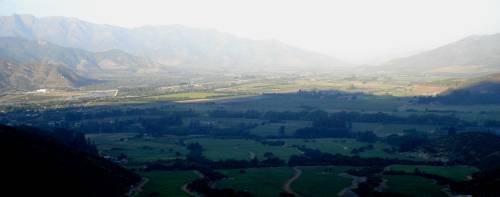
Looking
out over the biodynamic vineyards of Seña in Aconcagua
 Like
most places in the world, the word 'region' often confuses people when
interchanged with appellation or a specifically demarcated wine producing
area (AOC, DOC, DO etc.).
Like
most places in the world, the word 'region' often confuses people when
interchanged with appellation or a specifically demarcated wine producing
area (AOC, DOC, DO etc.).
So to clarify first. Chile has four actual wine producing regions, which
constitute a D.O. (Denomination of Origin); Coquimbo in the north, Aconcagua,
Central Valley and the Southern Region. Within these regions are sub-regions.
These are what we generally mean when we discuss a wine from a specific valley
in Chile.
Of course within sub-regions there are often even smaller distinguishable
appellations – intrinsically more interesting due to their unique terroir and
microclimates - but often a bit in-depth.
If you look at a map of Chilean
wine producing D.O.s (Denomination of Origin), you’ll notice they are focused
around the Central Valley and the capital city of Santiago. But newer vineyards
are popping up – in the north and in the south – driven by new technology and a
better understanding of terroir.
In the north,
Elqui and Limari are creating a buzz.
The most northern, Elqui Valley sits just below the Atacama Desert, about 500
kilometers from Santiago. The desert provides a long, dry season with typically
cool nights – grapes love cool nights after sun tanning all day long. Here
Cabernet Sauvignon is the most widely planted variety by far with meager pockets
of Merlot, Chardonnay, Carmenere, Sauvignon Blanc and Syrah.
Wines you may recognize from this region - Falernia
Below Elqui, about 400 kilometers north of Santiago, is the Limari Valley.
Traditionally known for its Moscatel grapes used in the production in the
Chilean favorite distilled liquor called Pisco, you will now find elegant Syrahs,
Sauvignon Bancs and Chardonnays taking a foothold in the calcium rich soils.
This minerality definitely shows in the wines. And, although Cabernet Sauvignon
vines still outnumber other varietals in Limari, the times, they are a-changin’.
Wines you may recognize from this region – Casa Tamaya and Maycas del
Limari.

Gardens
at Errazuriz
Aconcagua Valley is a far north as I traveled, and what a trip. Aconcagua
is, for all intents and purposes, Errazuriz. That isn’t saying that there are no
other producers here but it was Don Maximiano who pioneered the region in 1870
when most others were growing their grapes in Maipo – around Santiago.
Recognizing the quality of terroir in the Aconcagua he imported vines from
France – the beginning of a wine story that continues to make history with his
grandson, (now the fifth generation) Eduardo Chadwick. Not only is Errazuriz’s
famed Seña the first icon wine of Chile but in the last decade the premium wines
of Viña Errazuriz have gone head to head with some of the greatest wines in the
world – Château Margaux, Château Lafite and Château Latour as well as Solaia,
Tignanello and Sassicaia - and kicked some Euro butt.
Aconcagua’s unique and stable, cool-dry climate make this a region greatly
suited to organic and biodynamic viticulture. The region is small and quite
scattered. It weaves its way in odd swaths of land from the city of Los Andes at
the base of the Andes toward the port city of Valparaiso on the Pacific.
Aconcagua is also home to the highest Mountain peak in the Western Hemisphere –
Mount Aconcagua.
Wines you may know from this region –
Errazuriz, Seña, Arboleda
to read more on these
wines/wine producers click on the name above
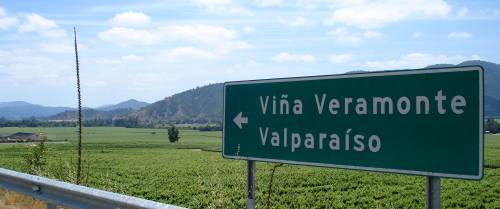
In
the Casablanca Valley
Below Aconcagua is Casablanca.
Right now, Casablanca seems to be the darling consumers are focused upon –
perhaps the romance of the name, but hopefully because we are finally starting
to understand the differences in terroir – and what unique characteristics a
region brings to a wine. Whereas every region north of Casablanca (and most of
those south as well) have more Cabernet Sauvignon planted than any other grape,
in Casablanca Chardonnay and Sauvignon Blanc rule. Only seventy-five kilometers
from Santiago, it is considered a cooler climate – close to the Pacific with fog
and often poor sandy soils that more suited to maintaining desirable acidity in
these varieties.
Casablanca is a circular region, about 4000 hectares in size, about seventy-five
kilometers west and a bit north of Santiago.
Wines you would recognize from Casablanca – Veramonte, Vina Mar, Loma
Larga, Morandé, Casablanca and Casas del Bosque.
Directly below Casablanca, between Santiago and the Pacific Ocean, is the San
Antonio Valley. Anchored by the port city of San Antonio, like Casablanca
this cool climate region does well with grapes that respond well to higher
acidity. The vineyards in San Antonio, and it famous sub-appellation Leyda, are
become renowned for their elegant Syrahs, Sauvignon Blancs and Pinot Noirs.
Wines you may know from San Antonio – Matetic and Leyda.

Tarapacá - the Estate
The most densely packed, and
the most recognizable of the DO Valleys is Maipo.
Maipo attaches itself to Santiago on the east, drifting above and below the city
while ebbing and flowing in a south-westerly direction toward the ocean. Here is
where you truly begin to recognize the differences in terroir not just north and
south (as one would suppose in a sylph-like country like Chile), but east to
west. The eastern regions closest to the Andes have harsh, rocky colluvial soil
compositions made up of millennia of mountain decomposition. These higher
vineyard sites receive warm daylight sun and cool nights for balance and
complexity. The mid-valleys gather more heat - sandwiched in the middle – with
less cooling breezes from the Pacific and they are more arid. The valley soils
are comprised of mineral run-off from the melting Andes snow caps and smooth
stones (alluvial soil) from old river beds. Of course the maritime clime near the water is again
different, more moisture and fog – the soils, although fertile, are often sandy.
In Maipo these regions are recognized as Alto Maipo (at the base of the Andes),
Central Maipo (in the valley base) and Pacific Maipo.
Wines you may know from here – Cousiño Macul, Santa Carolina, Valdivieso,
Concha Y Toro, Haras de Pirque, Carmen, Santa Rita, Terra Mater, Baron Philippe
de Rothschild, De Martino, Tarapacá and Undurraga
Read about some of these wineries
here

Gardens
at Santa Rita

View over
Colchagua from Luis Felipe Edwards mountaintop vineyard
Rapel Valley is actually
broken into two sub-appellations – Cachapoal and Colchagua. In the
Rapel the heat is immediately obvious and drip irrigation is common. Taking
advantage
of higher temperatures for ripening and tannin structure, red varieties abound. Cachapoal is the more northerly, and easterly of the two appellations (only
about 60 kilometers from Santiago) but both have a similar breakdown of vine
plantings – predominantly Cabernet Sauvignon followed by Merlot and Carmenere.
Colchagua is roughly double the size of Cachapoal and rolls across Chile from
the Andes, almost to the Pacific. Like Maipo Valley Colchagua enjoys three diverse terroirs – the Andes, the Valley and the Pacific. It was in the Valley of
Colchagua that we wove our way up steep mountain slopes in four-wheel drive
trucks, for nearly half an hour, to vineyards at 1000 m above sea level at Luis
Felipe Edwards. The planting and irrigation systems are fantastic, the slopes
treacherous but the views – stunning. And it was also here that the spring sun
baked. The temperatures during my visit rose above 36 degrees which made hats essential
while touring various vineyards,
Wines you may know from Cachapoal – Anakena, Morandé
Wines you may know from Colchagua – Casa Silva, Orgánicos Emiliana, Cono
Sur, Montes, Casa Lapostolle, Ninquén, Estampa, MontGras, Caliterra, Terra
Andina and Luis Felipe Edwards
link
here to read about the wineries of Rapel

Learning about biodynamic viticulture at Cono Sur from winemaker Matias Rios
Curicó Valley begins
just under Cachapoal and runs south through central Chile with an arm of land
which reaches toward the ocean. It is the third largest wine growing valley in
Chile and is located just under 200 kilometers from Santiago. Curicó also has
more Sauvignon Blanc vineyards than any other region in the country, but that
number is still far less than its quantity of Cabernet Sauvignon vines.
Wines you may know from Curicó - Miguel Torres, Valdivieso, Echeverria,
Aresti

Sunset at the ranch
winery of J.Bouchon
Maule Valley is a
sizeable DO (Denomination of Origin), the largest by far encompassing 31,000
hectares of vines. This is an old region; some vineyards are up to 200 years
old. But the region fell out of favour, perhaps for vineyards closer to Santiago.
But there does seem to be some revitalization here. Grafting noble varieties
onto gnarled Pais vines (Pais is a native red grape variety) has been attempted,
the addition of modern irrigation and replanting bush or overhead (pergola)
trellised vines with newer noble varieties and training systems. But despite the
changes in the Maule, Pais still runs a close second to Cabernet in total
planted vineyard hectares. And Pais is not an easy grape to love. It’s a
vigorous, high yield, thin-skinned grape that manages well without irrigation
but is recognized more as a jug wine variety. Even the premium Pais I tasted
while in Chile was difficult to like – it was quite harsh, chewy in fact and
lacked real finesse or elegance.
Wines you may know from Maule – Botalcura, Calina, Terranoble, Cremaschi
Furlotti, Gillmore Estate and J. Bouchon.
Despite the size of the
Itata Valley (nearly 10,500 hectares of vines) the odds are you haven’t
heard of it. Planted primarily with Muscat of Alexandria and Pais this is
fantastically the oldest new world wine region in the new world. Spanish colonists
settled here and planted vines some 450 years ago. It’s still a very traditional
region which is changing and modernizing, slowly. Other plantings include;
Cabernet Sauvignon, Chardonnay, Cinsault, Carignan and Semillon.
It seems as though Cono Sur has
single handedly put Bio Bio Valley on the map with its cold- climate
Gewürztraminers and Rieslings that are made from their vineyards here. There is
growing interest in this DO (Denomination of Origin), for Sauvignon Blanc,
Chardonnay and Pinot Noir as well. Its not only cold here, but wet – thus
creating some pretty interesting challenges that can be worth the slow-ripening,
high-acid, final product. Located some 600 kilometers south of Santiago, the
Bio Bio and the Malleco Valleys are home to some of the most southerly
vineyards in the world.|
And finally, the Pacific Ocean...
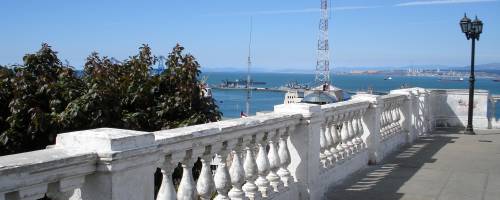
Valparaiso
The best ways to see Chile...
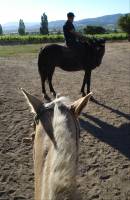
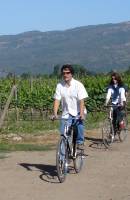
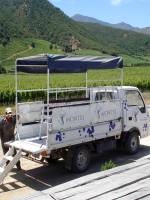
More on the wines and
producers of Chile from:
Aconcagua - click here
Maipo Valley - click here














